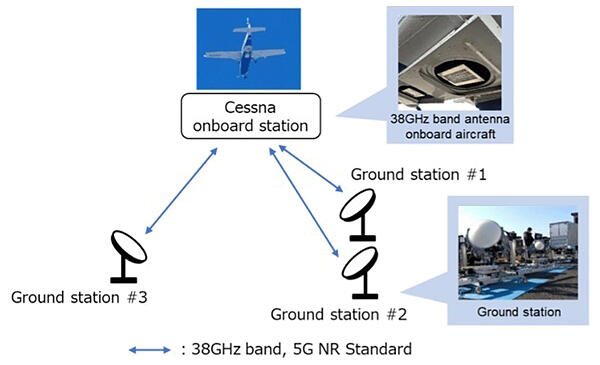SKY Perfect JSAT, NTT DOCOMO, the National Institute of Information and Communications Technology (NICT), and Panasonic Holdings, Inc. announced on May 28 that they have successfully conducted the world's first 5th-generation (5G) communication verification experiment using 38-GHz band radio waves from an altitude of approximately 4 km by employing a small airplane that simulates a High-Altitude Platform Station (HAPS). HAPS is an unmanned aerial vehicle that can fly nonstop in the stratosphere approximately 20 km above the ground for long periods of time from a few days to several months. By mounting a repeater and other equipment on the aircraft, it will be possible to create a wireless communication service area of 100-200 km in diameter. For this reason, the expansion of the service area is considered so that it covers the following areas: the sky and sea, where it has been difficult to provide wireless communication services; and depopulating and mountainous areas that have not been covered due to the lack of profitability.

Provided by SKY Perfect JSAT
The group conducted a verification experiment to demonstrate the practical application of feeder links and backhaul lines that are necessary to realize a 5G communication network using HAPS. The feeder links are communication lines connecting HAPS and terrestrial gateway stations. The backhaul lines are fixed lines for high-speed, large-capacity information transmission between numerous wireless base stations and the core network (backbone network) in the mobile communication network. A 38-GHz band 5G NTN (non-terrestrial network) communication base station and core network equipment, newly developed for installation in HAPS, were installed in a Cessna aircraft (Cessna onboard station). A lens-type antenna with an automatic tracking function was used as the HAPS ground station (ground station), which was developed to transmit and receive radio waves in the 38-GHz band with a high-gain and sharp beam.
This experiment demonstrated that a terrestrial 5G network backhaul circuit by the overhead relay of 5G (NR system) can be established using 38-GHz band radio waves between a station onboard a Cessna aircraft at an altitude of approximately 4 km and three ground stations. Furthermore, end-to-end communication to mobile terminals was demonstrated by applying these technologies to backhaul lines between the base stations that communicate with mobile terminals and core network for end-to-end communication. The NR system is a new radio-access technology specified by the 3rd-Generation Partnership Project (3GPP) for 5G mobile communication systems. This is the world's first attempt to demonstrate a backhaul line comprising multiple links being relayed over air in 5G (NR system) using the 38-GHz band radio waves.
This article has been translated by JST with permission from The Science News Ltd. (https://sci-news.co.jp/). Unauthorized reproduction of the article and photographs is prohibited.




